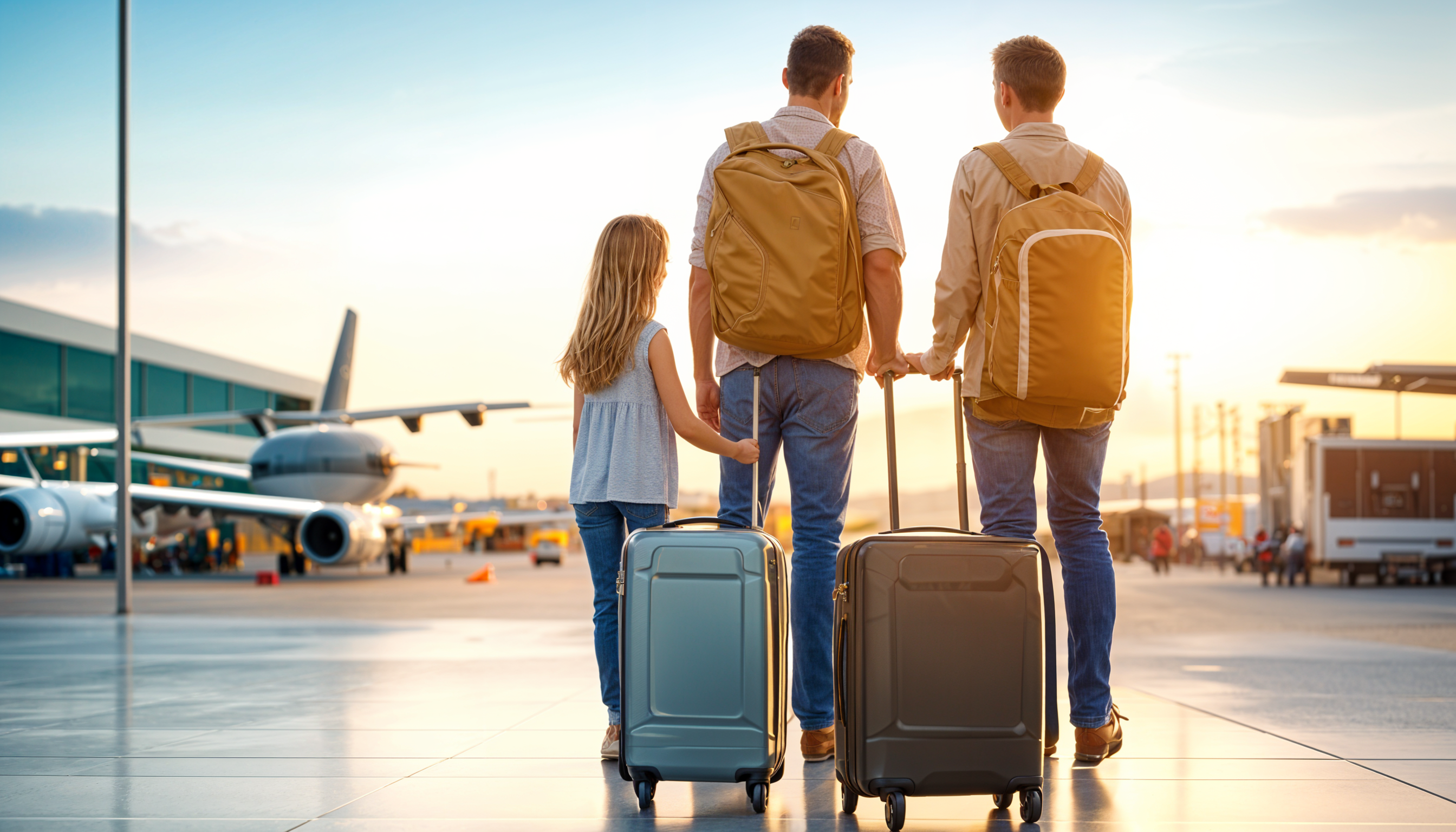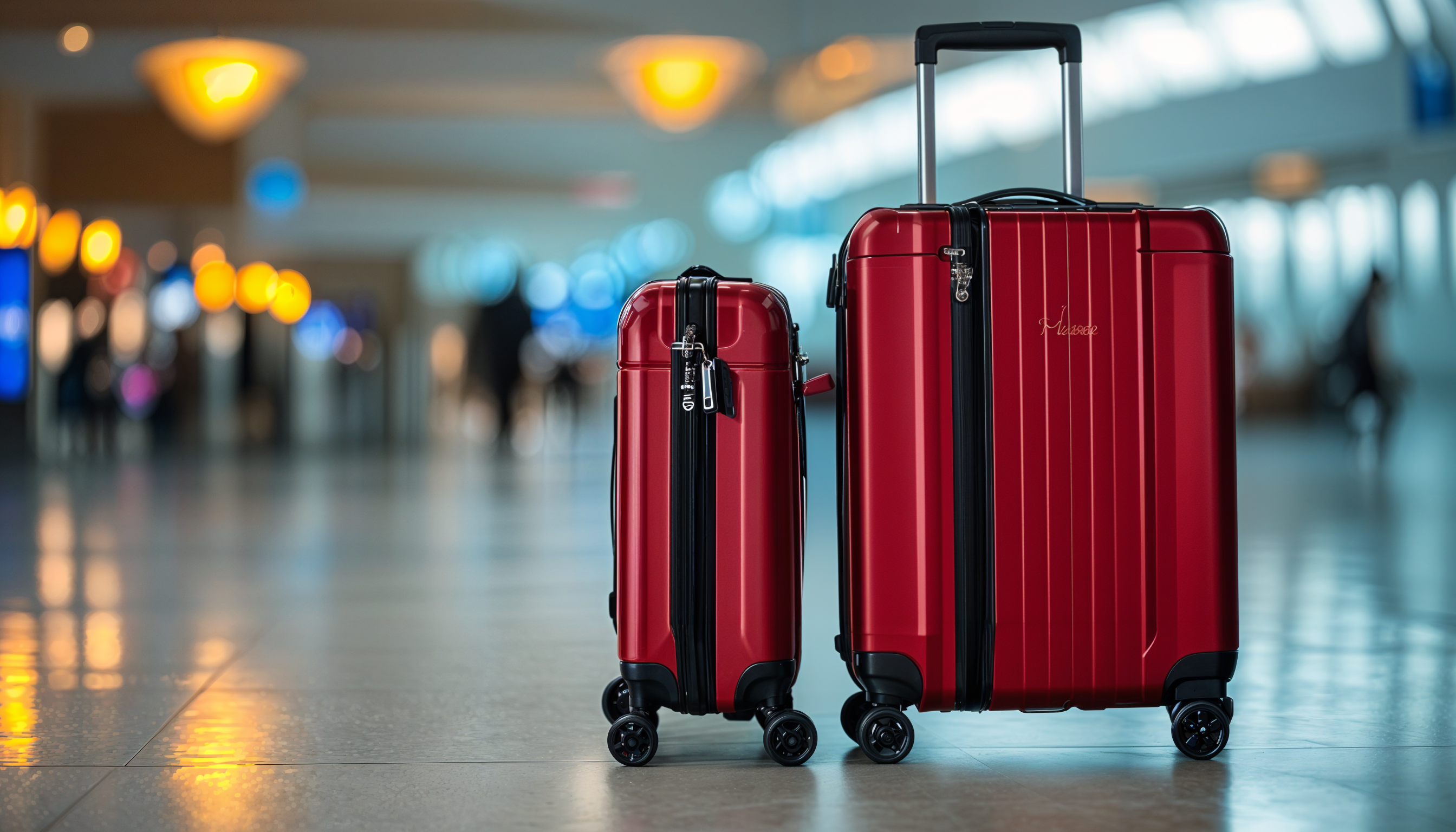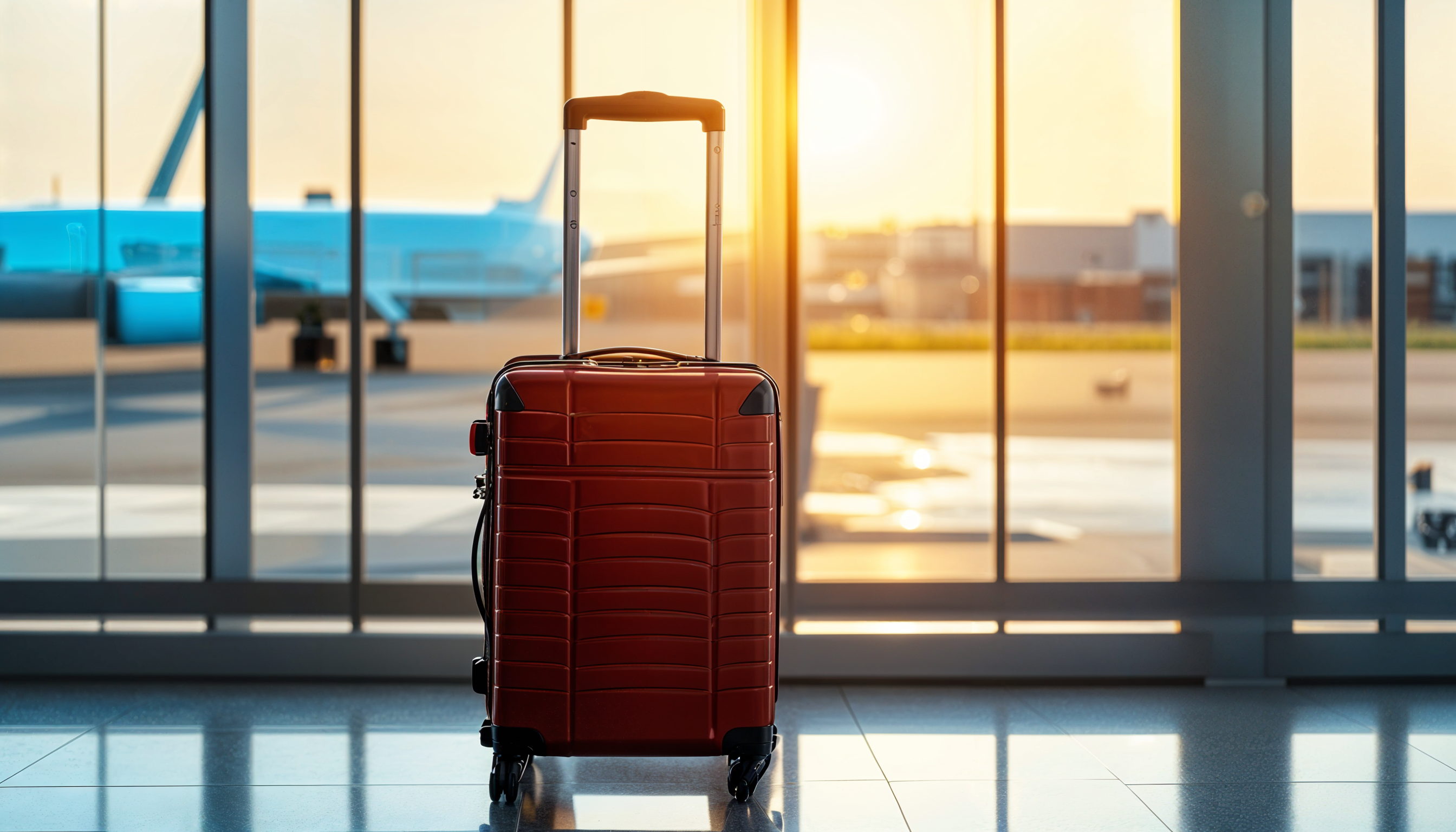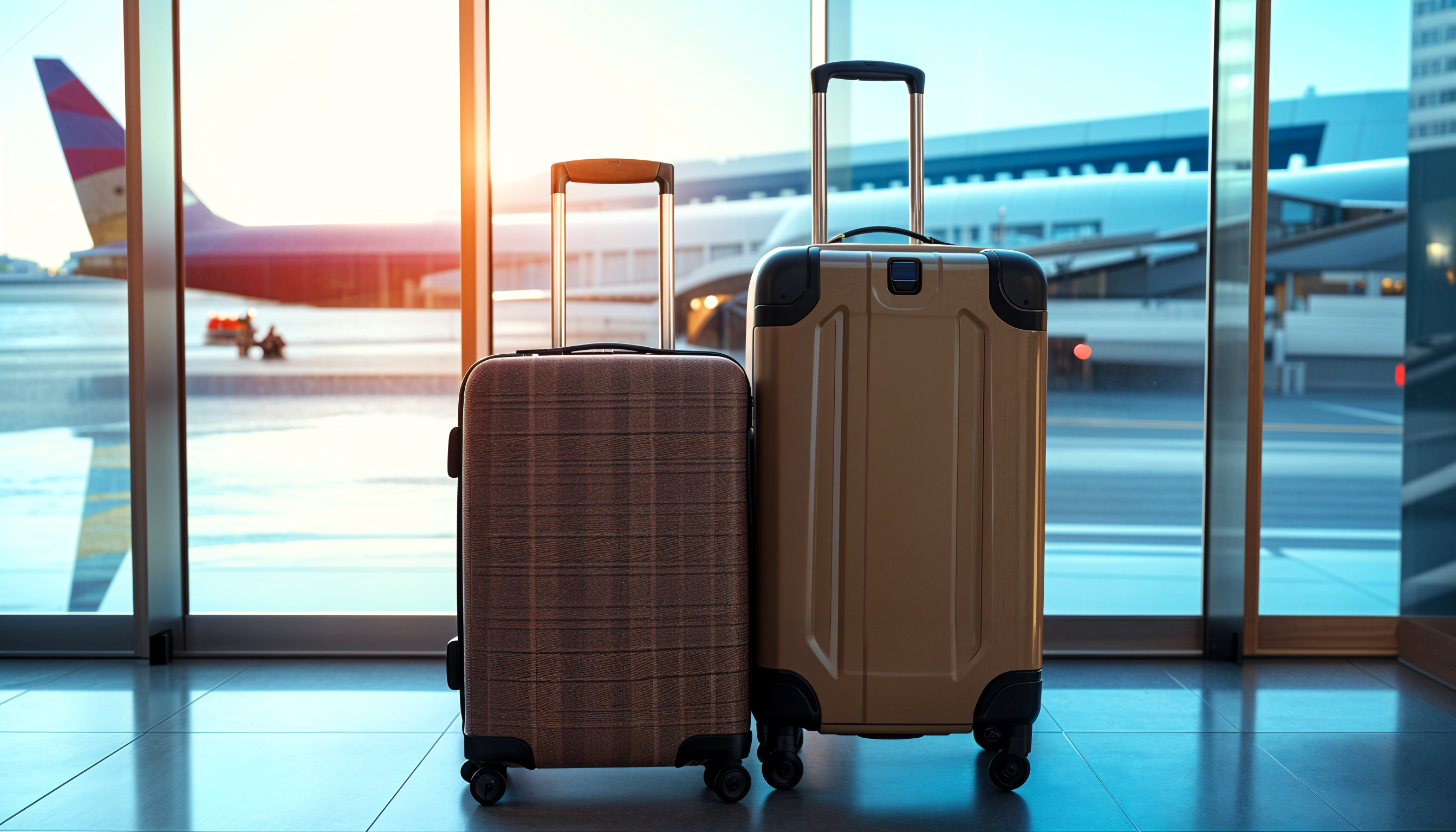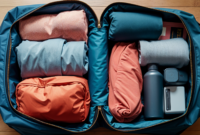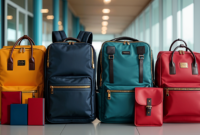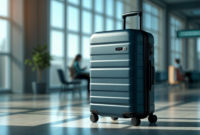When it comes to air travel, one of the first decisions you face is what type of luggage to bring: carry-on or checked. Carry-on luggage refers to smaller bags that you can bring with you onto the airplane, typically stowing them in the overhead compartments or under the seat in front of you. This allows you to keep your essentials, valuables, and fragile items close at hand throughout your journey. However, before you pack that carry-on, it’s crucial to understand the restrictions that airlines impose on their size and sometimes weight. Failing to comply with these limitations can lead to unexpected fees or the inconvenience of having your bag gate-checked.
Opting for carry-on luggage offers several advantages. Firstly, it can save you money by avoiding checked baggage fees, which can be substantial depending on the airline and your destination. Secondly, it streamlines your airport experience, allowing you to bypass baggage check-in and reclaim, saving you valuable time and potential delays. Lastly, it minimizes the risk of your luggage getting lost or damaged during transit, as it remains under your supervision throughout the journey.
However, carry-on luggage also comes with limitations. The restricted size can make packing for longer trips or those requiring specialized gear challenging. Additionally, overhead bin space can be limited, especially on full flights, potentially leading to your carry-on being gate-checked despite your best efforts.
To help you navigate this luggage dilemma, this article will explore the key factors to consider when choosing between carry-on and checked luggage. We’ll delve into the specifics of carry-on and checked luggage restrictions, baggage fees, packing tips, and real-life scenarios to illustrate the best choice for various travel situations. By understanding the pros and cons of each option and considering your individual needs – such as trip length, travel style, and packing preferences – you can confidently make the right luggage choice for a smooth and enjoyable travel experience.
Understanding Carry-On Luggage
Carry-on luggage refers to the bags you can bring with you onto the airplane and stow either in the overhead bins or under the seat in front of you. These bags can range from duffel bags and backpacks to smaller roller suitcases. Typically, the maximum allowed dimensions for carry-on luggage on domestic flights within the US are 22″ x 14″ x 9″. However, international standards often lean towards slightly smaller dimensions, around 21″, so it’s always wise to check with your specific airline before you travel.
Why Choose Carry-On?
There are several compelling reasons to opt for carry-on luggage. Firstly, it can save you a significant amount of money. Many airlines charge fees for checked bags, which can range from $30 to upwards of $200 per bag, depending on the airline and your route. By sticking to a carry-on, you can bypass these fees altogether.
Secondly, using carry-on luggage streamlines your airport experience. You avoid the often lengthy process of checking bags at the ticket counter and the wait at baggage claim upon arrival, allowing for a quicker and smoother journey. Lastly, and perhaps most importantly for some, keeping your belongings with you in the cabin minimizes the risk of your luggage getting lost or damaged during transit. You have peace of mind knowing your essentials and valuables are always within reach.
Navigating Restrictions and Limitations
While carry-on luggage offers numerous advantages, it’s essential to be aware of the restrictions and limitations that come with it. Airlines have specific size and weight restrictions to ensure that bags fit safely in overhead compartments. While the 22″ x 14″ x 9″ rule is generally accepted for domestic US airlines, some, like Frontier and Southwest, are more generous, allowing 24-inch bags. However, international airlines and budget carriers often have smaller size limits. It’s crucial to check your airline’s specific baggage policy before packing to avoid unexpected fees or the inconvenience of having your bag gate-checked at the last minute.
In addition to airline regulations, you also need to be mindful of the Transportation Security Administration (TSA) regulations, particularly regarding liquids and prohibited items. The TSA’s 3-1-1 rule states that liquids, gels, and aerosols in carry-on luggage must be in containers of 3.4 ounces (100 milliliters) or less and must fit in a single quart-sized clear zip-top bag. This includes items like toiletries, beverages, and some food items.
Certain items are strictly prohibited in carry-on luggage for safety reasons, including firearms, lithium batteries, sharp objects (like scissors and knives), and anything that could be considered a weapon. A comprehensive list of prohibited items can be found on the TSA website.
Tips for Packing Like a Pro
Packing efficiently is key to maximizing your carry-on luggage space. Start by measuring your suitcase to ensure it meets your airline’s specific size requirements. Adhere to the 3-1-1 liquids rule by using travel-sized containers for toiletries. Create a detailed packing list to avoid overpacking and ensure you don’t forget any essentials. Plan your outfits in advance to minimize the number of clothing items you need. Consider wearing your bulkiest items, like jackets and boots, to the airport to save space in your luggage.
Utilize packing cubes to organize your belongings and maximize space. Fold clothes vertically using the KonMari method to save space and make items more visible. Pack electronics in padded cases and place them between layers of clothing to prevent damage. Bring a smaller personal item bag, like a purse or small backpack, for easy access to essentials during the flight.
Pack an empty, foldable tote bag for shopping and souvenirs to avoid overfilling your carry-on on your return trip. Downsize containers by transferring toiletries and other products into smaller, travel-sized versions. Pack shoes in a travel shoe bag to protect your belongings from dirt and germs. Bring a travel laundry bag to separate dirty clothes from clean items. Finally, consider replacing physical books and entertainment with digital versions on your smartphone or tablet.
| Airline | Carry-on Size (inches) | Personal Item Size (inches) | Weight Limit |
|---|---|---|---|
| American Airlines | 22 x 14 x 9 | 18 x 14 x 8 | None |
| Delta Air Lines | 22 x 14 x 9 | 18 x 14 x 8 | None |
| United Airlines | 22 x 14 x 9 | 17 x 10 x 9 | None |
| Southwest Airlines | 24 x 16 x 10 | 18.5 x 8.5 x 13.5 | None |
| JetBlue Airways | 22 x 14 x 9 | 17 x 13 x 8 | None |
| Frontier Airlines | 24 x 16 x 10 | 18 x 14 x 8 | None |
| Spirit Airlines | 22 x 18 x 10 | 18 x 14 x 8 | None |
Exploring Checked Luggage
Checked luggage refers to the larger bags that you hand over to the airline at the check-in counter. These bags are then stored in the aircraft’s cargo hold during the flight and are returned to you at baggage claim upon arrival. Checked luggage serves a crucial purpose in air travel by allowing you to transport items that are too large, heavy, or numerous to be carried on board in your carry-on luggage.
The Upsides of Checking Your Bags
One of the primary advantages of checked luggage is its increased capacity. Checked bags are significantly larger than carry-on bags, providing ample space for all your belongings, especially for longer trips or when traveling with family. This extra space eliminates the need to meticulously pare down your packing list and allows you to bring everything you need without worrying about size restrictions. Another benefit is the freedom from liquid restrictions.
Unlike carry-on bags, which are subject to the TSA’s 3-1-1 rule for liquids, checked luggage has no such limitations. You can pack full-size toiletries, beverages, and other liquids without worrying about transferring them to smaller containers. Furthermore, checking your bags significantly reduces the physical burden of lugging heavy bags through the airport.
This can be a major advantage for travelers with physical limitations, families with young children, or anyone who simply prefers a more comfortable and less strenuous airport experience. Finally, checking your bags can lead to a more relaxed boarding process. You don’t need to compete for limited overhead bin space or worry about your bag being gate-checked at the last minute.
The Potential Downsides of Checked Luggage
While checked luggage offers several advantages, it’s essential to be aware of the potential drawbacks. The most significant disadvantage is the cost of baggage fees. Most airlines charge fees for checked bags, which can vary depending on the airline, route, fare type, and the number of bags checked. These fees can add a considerable expense to your trip, especially if you’re traveling on a budget or with a basic economy fare.
Another concern is the risk of lost or damaged luggage. While airlines have made significant improvements in baggage handling, there’s always a chance that your checked bag could be lost, delayed, or damaged during transit. This can be a major inconvenience, especially if your bag contains essential items like medication, electronics, or important documents. Additionally, waiting at baggage claim can be time-consuming, adding to your overall travel time and potentially causing delays in reaching your final destination.
Checking In Your Luggage: A Step-by-Step Guide
The process of checking in your luggage at the airport is relatively straightforward. When you arrive at the airport, proceed to your airline’s check-in counter. The airline agent will weigh your bags, tag them with a unique baggage claim tag, and print a baggage claim receipt for you to keep. Your luggage will then be transported to the aircraft via a baggage handling system. During the flight, your checked bags will be stored in the plane’s cargo hold. Upon arrival at your destination, you’ll collect your luggage from the designated baggage claim area, using the baggage claim tag to identify your bag.
Packing Smart: Tips for Checked Luggage Safety and Security
To ensure the safety and security of your belongings, it’s crucial to pack your checked luggage strategically. Use durable luggage tags with your name, address, phone number, and email address, attaching one to the outside and another inside your bag. This will help the airline identify and return your bag if it gets lost. Invest in a TSA-approved luggage lock to deter theft and unauthorized access to your belongings.
Avoid packing valuable items like jewelry, electronics, cash, or important documents in your checked luggage, as they are more susceptible to loss or damage. When packing liquids, ensure they are in leak-proof containers and place them in a separate bag to prevent spills from damaging your other belongings. Consider using packing cubes to organize your clothes and other items, making it easier to find what you need and maximizing space. Finally, if you’re concerned about losing your luggage, you can place an AirTag or similar tracking device inside your bag to monitor its location and facilitate recovery in case of delays or loss.
| Airline | First Checked Bag Fee | Second Checked Bag Fee |
|---|---|---|
| Southwest Airlines | Free | Free |
| American Airlines | $30-$45 | $40-$55 |
| Delta Air Lines | $30-$40 | $40-$50 |
| United Airlines | $30-$40 | $40-$50 |
| JetBlue Airways | $35-$45 | $45-$55 |
| Alaska Airlines | $30-$40 | $40-$50 |
| Spirit Airlines | $30-$50 | $45-$65 |
| Frontier Airlines | $30-$50 | $45-$65 |
| Hawaiian Airlines | $30-$40 | $40-$50 |
Note: Checked baggage fees can vary depending on factors such as route, fare type, and elite status. It’s always best to check with your specific airline for the most up-to-date information on baggage fees.
Factors to Consider When Choosing
Choosing between carry-on and checked luggage isn’t a one-size-fits-all decision. It depends on a variety of factors unique to your travel style, the specifics of your trip, and your personal preferences. To make the best choice for a smooth and stress-free journey, carefully consider the following:
Trip Length and Packing Needs: The duration of your trip plays a significant role in determining your luggage needs. For a quick weekend getaway, you can likely pack everything you need into a carry-on suitcase. Imagine a weekend trip to a city like Chicago – you could easily fit a few outfits, toiletries, and a pair of comfortable shoes in a carry-on. However, if you’re embarking on a longer adventure, such as a two-week backpacking trip through Southeast Asia, you’ll likely need the extra space afforded by a checked bag to accommodate more clothing, gear, and souvenirs.
Travel Style and Packing Tendencies: Are you a minimalist packer who thrives on traveling light, or do you prefer to have a variety of options at your disposal? If you identify as a minimalist, you might find a carry-on perfectly sufficient for most trips. However, if you tend to overpack or simply enjoy having more choices, the spaciousness of a checked bag might be a better fit for your travel style.
Baggage Fees and Cost Considerations: Baggage fees can significantly impact the overall cost of your trip. Many airlines, especially budget carriers like Spirit and Frontier, charge for both checked and carry-on bags. If you’re traveling on a tight budget, opting for a carry-on can help you avoid these extra costs. However, some airlines, like Southwest, still offer two free checked bags, making checked luggage a more appealing option in those cases. Weigh the potential cost savings of carry-on against the convenience of checking a bag, especially if you’re traveling with a lot of gear or prefer not to lug a heavy bag through the airport.
Number of Items and Weight Restrictions: The sheer volume and weight of the items you need to pack can dictate your luggage choice. For a short business trip where you only need a few outfits and your laptop, a carry-on and a laptop bag might be perfectly adequate. However, if you’re going on a ski trip and need to pack bulky winter clothing, boots, and possibly even ski equipment, a checked bag becomes a necessity.
Keep in mind that airlines have weight restrictions for both carry-on and checked luggage. Exceeding these limits can result in hefty fees at the airport. For example, some airlines have carry-on weight limits as low as 11 pounds, while checked bags generally have a limit around 70 pounds.
Restricted Items and Liquids: Certain items are strictly prohibited in carry-on luggage for safety reasons. This includes liquids in containers larger than 3.4 ounces, sharp objects like knives (with some exceptions), and items like lithium batteries. If you need to carry full-size toiletries, makeup, or sports equipment, you’ll have no choice but to check your bag. For example, if you’re a scuba diver traveling with your own gear, you’ll need to check your dive knife and other equipment that cannot be carried on board.
Real-Life Scenarios: Let’s consider a few real-life scenarios to illustrate how these factors can influence your luggage choice:
- Scenario 1: Business Trip: You’re flying to New York for a two-day business meeting. You need a suit, a few shirts, toiletries, and your laptop. In this case, a carry-on suitcase and a laptop bag would be sufficient, allowing you to avoid baggage fees and streamline your airport experience.
- Scenario 2: Family Vacation: You’re taking your family of four on a week-long beach vacation. You need clothes, swimsuits, beach towels, sunscreen, and toys for the kids. Given the volume of items and the need for larger containers of liquids like sunscreen, checking a bag for each family member would likely be the most practical option.
- Scenario 3: Camping Trip: You’re heading out on a week-long camping adventure in a national park. You need a tent, sleeping bag, cooking gear, hiking boots, and clothing for all types of weather. The bulky nature of camping gear and the potential need for items like a camping knife would necessitate checking a bag.
By carefully considering these factors and applying them to your specific travel situation, you can make an informed decision about whether to travel with carry-on or checked luggage.
Benefits of Carry-On Luggage
Embrace the freedom and efficiency of traveling light with only carry-on luggage. By opting to keep your belongings with you throughout your journey, you unlock a world of advantages that can significantly enhance your travel experience.
One of the most appealing aspects of carry-on luggage is the sheer convenience and time savings it offers. Imagine bypassing the often lengthy check-in lines and heading straight to security. Upon arrival, you skip the dreaded baggage carousel wait and head directly to your destination. This streamlined airport experience can save you valuable time, especially during tight connections or when you’re eager to start exploring your destination.
Beyond the airport, carrying your luggage allows for greater agility and flexibility throughout your trip. Navigating crowded train stations, climbing stairs, or hopping on and off public transportation becomes significantly easier without the burden of a heavy checked bag. You’ll be able to move more freely and efficiently, making your travels more enjoyable and less physically demanding.
Perhaps the most significant advantage of carry-on luggage is the reduced risk of lost or delayed baggage. While airlines have improved their baggage handling systems, lost luggage remains a frustrating reality for many travelers. By keeping your belongings with you in the cabin, you eliminate this worry altogether. You’ll have peace of mind knowing that your essential items, valuables, and fragile belongings are always within reach and safe from the potential mishaps of baggage handling.
Successfully traveling with only a carry-on does require a bit of strategic packing. Start by planning your outfits in advance to avoid overpacking. Wear your bulkiest items, like jackets and boots, to the airport to save space in your luggage. Utilize packing cubes to maximize space and keep your belongings organized. Downsize your toiletries and liquids to meet the TSA’s 3-1-1 rule. Consider packing a lightweight, foldable tote bag for souvenirs and shopping to avoid exceeding carry-on restrictions on your return trip. By packing strategically and prioritizing essential items, you can enjoy the many benefits of carry-on travel without feeling limited by space.
When Not to Use Carry-On Luggage
While carry-on luggage offers numerous advantages, there are certain situations where it may not be the most practical or convenient choice. Understanding these limitations can help you make an informed decision about your luggage strategy and avoid potential travel headaches.
Limited Packing Space for Longer or Family Trips: The restricted size of carry-on luggage can pose a significant challenge for longer trips or when traveling with family. If your trip exceeds 4-5 days, especially if you’re heading to a destination with varying weather conditions, you may struggle to fit all your necessary clothing and essentials into a carry-on.
For example, packing for a 2-week European adventure with diverse climates and activities would likely require more space than a standard carry-on allows. Similarly, traveling with children often means packing multiple outfits, diapers, toys, and other necessities, quickly exceeding the capacity of a single carry-on per person. In such cases, checking luggage might be a more practical solution to avoid overpacking and potential baggage fees for exceeding carry-on size or weight limits.
Navigating Liquid Restrictions: The TSA’s 3-1-1 rule for liquids in carry-on luggage can be a major constraint for some travelers. If you rely on specific toiletries, makeup products, or medications that exceed the 3.4-ounce limit, you’ll have no choice but to check your bag. For example, if you need to carry larger bottles of shampoo, conditioner, or lotion, or if you’re traveling with a baby and need to bring formula or breast milk in quantities exceeding the allowed limit, checking your luggage becomes necessary.
Transporting Bulky or Restricted Items: Carry-on luggage is not suitable for transporting bulky items like sports equipment (skis, golf clubs, etc.), musical instruments, or large souvenirs. These items often exceed the size and weight restrictions for carry-on luggage and will need to be checked. Additionally, certain items are strictly prohibited in carry-on luggage for safety reasons, including sharp objects like knives (with some exceptions), tools, and flammable materials. If you need to travel with any of these items, you’ll have to check your luggage.
Maneuvering Crowded Airports: Navigating crowded airports, security lines, and narrow airplane aisles with a carry-on can be a challenging and potentially stressful experience. This is especially true if you’re traveling with young children, have mobility issues, or are simply trying to avoid the hassle of maneuvering a bulky bag through tight spaces. In such situations, checking your luggage can provide a more comfortable and less stressful airport experience. You’ll be able to move more freely without the burden of a carry-on, and you won’t have to worry about finding space for it in the overhead bins.
Potential for Gate-Checking: Even if you meticulously pack your carry-on to meet size and weight restrictions, you may still encounter situations where you’re forced to gate-check your bag. This can happen on full flights where overhead bin space is limited, or if you’re traveling on a smaller aircraft with smaller bins. Gate-checking essentially negates the benefits of carrying your luggage on board, as you’ll have to wait for it at baggage claim upon arrival, just like a checked bag. If you’re concerned about the possibility of gate-checking, especially if you have fragile items or essential medications in your carry-on, checking your luggage from the start might be a safer bet.
When to Use Checked Luggage
While carry-on luggage offers its own set of advantages, there are certain travel scenarios where checking your bags becomes the more practical and even preferable option. If your travel plans involve any of the following, you might want to consider the convenience and benefits of checked luggage.
Extended Trips and Bulky Gear: When you’re embarking on a longer journey, especially one that lasts several weeks or even a month or more, the increased packing capacity of checked luggage becomes invaluable. Imagine packing for a month-long backpacking trip through Europe – you’ll need space for a variety of clothing options, toiletries, and perhaps even some souvenirs. Similarly, if your travels involve bulky or heavy items like winter sports equipment (skis, snowboards, boots), camping gear, or musical instruments, checking your bag is the only way to transport these items safely and efficiently.
Freedom from Liquid Restrictions: Checked luggage offers a significant advantage for those who prefer to travel with full-size toiletries or need to carry liquids in quantities exceeding the TSA’s 3-1-1 rule for carry-on bags. You can pack your favorite shampoo, conditioner, and other essentials without the hassle of transferring them into smaller containers. This is particularly beneficial for families traveling with young children who require larger quantities of baby products or for individuals with specific medical needs that necessitate carrying larger volumes of liquids.
Effortless Airport Navigation: Opting for checked luggage can significantly enhance your airport experience, especially if you’re traveling with a lot of gear, have mobility limitations, or simply prefer a more streamlined and less physically demanding journey. You can breeze through security checkpoints and navigate crowded terminals without the burden of a heavy carry-on bag. This can be particularly appealing for families with young children and strollers or for travelers with physical limitations who may find it challenging to maneuver a carry-on through the airport.
Peace of Mind and Stress-Free Travel: Checking your luggage provides a sense of peace of mind, knowing that your belongings are safely stowed away and will be waiting for you at your destination. You won’t have to worry about finding space in overhead bins or the possibility of your carry-on being gate-checked due to limited space. You can relax and enjoy your flight without the added stress of managing your luggage in the cabin. Additionally, checking your bag eliminates the risk of exceeding carry-on size restrictions, which can lead to unexpected fees at the gate.
Disadvantages of Checked Luggage
While checking your bags can offer convenience in certain situations, it’s crucial to be aware of the potential downsides that can significantly impact your travel experience. One of the most significant risks associated with checked luggage is the possibility of it getting lost during transit. While airlines have made strides in improving baggage handling, the reality is that checked bags are more susceptible to being misplaced or delayed compared to carry-on luggage.
SITA reported that 1.4 million items of luggage were lost in 2019 (SITA, 2019). This can be a major inconvenience, especially if your bag contains essential items like medication, electronics, or important documents.
The inconvenience caused by lost luggage can range from minor annoyances to major disruptions to your travel plans. Imagine arriving at your destination only to discover that your bag, containing all your clothes and toiletries, is nowhere to be found. You might find yourself having to attend a crucial job interview in jeans because your suit is lost, or you might be forced to wear your travel clothes to a fancy dinner on a cruise ship because your evening attire is missing. These situations can be stressful and frustrating, adding unnecessary complications to your trip.
Beyond the inconvenience of lost luggage, there’s also the potential for damage during handling. Checked bags are often subjected to rough treatment as they’re loaded and unloaded from aircraft and transported through baggage handling systems. A viral video titled “United Breaks Guitars” vividly illustrated the potential for damage to fragile items like musical instruments when they’re checked in (Dave Carroll Music, 2009).
Suitcases can get cracked or dented, car seats can be damaged, and sports equipment can be broken. While airlines typically offer compensation for damaged luggage, the process can be time-consuming and may not fully cover the cost of replacing your belongings.
Another disadvantage of checked luggage is the additional time it adds to your airport experience. You’ll need to factor in time for queuing at the check-in desk to drop off your bags, which can be particularly slow during peak travel times or if the airline is understaffed. Upon arrival, you’ll have to wait at baggage claim for your luggage to be unloaded and delivered, which can take anywhere from a few minutes to an hour or more, depending on the airport and the efficiency of the baggage handling system. This added waiting time can eat into your precious vacation time and potentially cause delays in reaching your final destination.
Finally, checking luggage often comes with a hefty price tag in the form of baggage fees. Most airlines, especially budget carriers, charge for checked bags, and these fees can quickly add up, especially if you’re traveling with multiple bags or have connecting flights. These fees can significantly increase the overall cost of your trip, making carry-on luggage a more budget-friendly option, especially for shorter trips where you can pack light.
Carry-on vs. Checked Bag: A Comparison Table
To help you visualize the key differences between carry-on and checked luggage, we’ve compiled a comprehensive comparison table. Use this table to weigh the pros and cons of each option and make an informed decision based on your individual travel needs and preferences.
| Feature | Carry-on Luggage | Checked Luggage |
|---|---|---|
| Size | 🧳 Generally within 20-25cm width, 33-38cm height, 48-58cm length (UK). Example: British Airways allows 56cm x 45cm x 25cm. | 🛄 Varies depending on the airline and flight destination. |
| Weight | ⚖️ Generally up to 23kg (UK). | 🏋️♀️ Generally up to 32kg (UK). |
| Fees | 💸 Typically free for 1-2 items (one personal item like a backpack). Some budget airlines, like Allegiant, charge for carry-on ($15-75). | 💰 Fees vary by airline, route, and time of booking. Often unavoidable for larger trips or specific items. |
| Convenience | 🚶 Pros: Faster airport experience (no check-in/baggage claim), luggage stays with you, readily accessible essentials. Cons: Size and weight restrictions, potential for gate-checking if overhead bins are full, can be cumbersome to carry. | 🛅 Pros: No need to carry heavy luggage, more packing space, can transport restricted items (liquids over 100ml). Cons: Check-in and baggage claim queues, risk of lost or damaged luggage, potential fees. |
| Security | 🔐 Safer as it remains with the owner at all times. Recommended for valuables. | ⚠️ Risk of damage or loss during transit. |
| Ideal Trip Length | 📅 Short trips (1-5 days), trips with frequent location changes. | 📆 Longer trips (6+ days), trips requiring bulky items (e.g., winter gear). |
The Bottom Line: Choosing the Best Luggage for Your Trip
Ultimately, the decision of whether to travel with carry-on or checked luggage is a personal one. There’s no single right answer, as the best choice depends entirely on your individual travel needs, preferences, and the specifics of your trip. As you’ve seen, both carry-on and checked luggage offer distinct advantages and disadvantages.
Carry-on luggage provides the freedom and efficiency of traveling light, allowing you to bypass check-in lines, avoid baggage fees (in many cases), and have immediate access to your belongings. However, it comes with limitations in terms of packing space and the potential for gate-checking if overhead bins are full.
Checked luggage, on the other hand, offers ample space for all your belongings, eliminates liquid restrictions, and frees you from carrying heavy bags through the airport. But it also comes with the risk of baggage fees, potential delays or loss, and the added time required for check-in and baggage claim.
Before making your decision, carefully consider the factors we’ve discussed throughout this article: the length of your trip, your packing style, the potential cost of baggage fees, the number and type of items you need to pack, and the ease of navigating your destination with your luggage.
To avoid any surprises at the airport, it’s always a good idea to check your airline’s specific baggage policies regarding size and weight restrictions, as well as any applicable fees.
Finally, regardless of your choice, invest in quality luggage that is durable, lightweight, and meets your specific needs and travel style. A good suitcase can be a travel companion for many years to come.
By carefully weighing the pros and cons and considering your individual circumstances, you can confidently choose the best luggage option for your next trip, ensuring a smooth, stress-free, and enjoyable travel experience.

